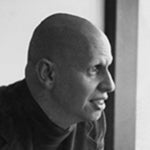David Antin
Posted in Past Guests | Tagged A–F
 Poet, artist, and critic David Antin received an MA in linguistics at City College of New York, where he studied with Gertrude Stein. David Antin invented a genre: the talk poem. Combining lecture, story-telling, lyric intensity, improvisational reach, and memoir, his performances lead to unexpected avenues of social commentary even for the poet, since they do not rest upon any prior text. He has performed his pieces at the Whitney, Guggenheim, and the Museum of Modern Art, among other venues. Emerging in the decade of the New American Poetry, he was one of the earliest critics to write on postmodernism, and his work makes it meaningful to speak still of an American avant-garde. His published books include Talking at the Boundaries, After the War (A Long Novel with Few Words), Tuning, and What It Means to Be Avant-Garde.
Poet, artist, and critic David Antin received an MA in linguistics at City College of New York, where he studied with Gertrude Stein. David Antin invented a genre: the talk poem. Combining lecture, story-telling, lyric intensity, improvisational reach, and memoir, his performances lead to unexpected avenues of social commentary even for the poet, since they do not rest upon any prior text. He has performed his pieces at the Whitney, Guggenheim, and the Museum of Modern Art, among other venues. Emerging in the decade of the New American Poetry, he was one of the earliest critics to write on postmodernism, and his work makes it meaningful to speak still of an American avant-garde. His published books include Talking at the Boundaries, After the War (A Long Novel with Few Words), Tuning, and What It Means to Be Avant-Garde.
ALLEGORY
that it was an allegory of his life is incontestable
though its meaning may remain forever obscure
through lack of a key
say it is an allegory of his life
a man stuffed with arrows and a checkered floor
say that the arrows are opinions and that the floor
is an attitude rejecting all accidents
say it is an allegory in which the river is the hour
that saw the birth of his eye
say that the rock was the stubbornness of his hands
confronted by obstacles that the city was
an angle of sunlight made at a certain hour
that it was an allegory in which each of the
children were the odors of particular months
heralding a change in the weather
say that it is an allegory and that the sunlight was the memory
of a glass of water
say that all of the figures were syllables of a language spoken
by fur-coated strangers of the roles f a games he had once
seen played that the sword was a letter he had written
to the Doge or an opinion on astronomy
that the three distances were stages of contemplation
or the stages of an insect’s life
of which the foreground was the larval stage the middle distance
a cocoon and the background the escaping imago
say that the mountain was a hostile color
and the man in the cell a failure to perceive
say it is an allegory of his life
in which the frame was his body dissected
with the bones laid bare and the veins
and the corpuscles projected on the canvas
say that the clouds were his eyes travelling
toward unseen birds
say that the subject of the painting was time
in the shape of the moon that was an
yet unseen behind the rim of the horizon
toward which it had been travelling all day forward
Links
- “Conversational Critic, Talking Poet David Antin” by Robert L. Pincus. San Diego Reader. 10 August 2011.
- Review of A Conversation with David Antin by Caroline Bergvall. Jacket. May 2003.
- “Talking and Thinking,” Interview with Hazel Smith and Roger Dean. Postmodern Culture. May 1993.
Media
Reading with John Yau | November 11, 2002
Talking Poetics, Naming Identities
